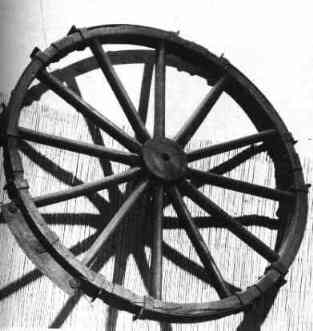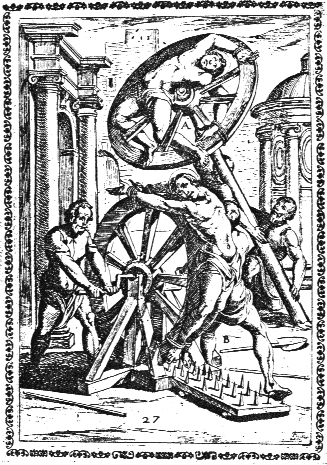The Wheel


Picture #3
Picture #4
Picture #5
The Wheel


Picture #3
Picture #4
Picture #5
The Wheel
Being broken or "braided" on the wheel was one of the most insidiously painful methods of torure and execution practised in Europe.
After hanging, “breaking with the wheel” was the most common means of execution throughout Germanic Europe from the early Middle Ages to the beginning of the eighteenth century; in Gallic and Latin Europe the breaking was done with massive iron bars and with maces instead of wheels.
The victim, naked, was stretched out supine on the ground or on the execution dock, with his or her limbs spread, and tied to stakes or iron rings. Stout wooden crosspieces were placed under the wrists, elbows, ankles, knees and hips. The executioner then smashed limb after limb and joint after joint, including the shoulders and hips, with the iron-tyred edge of the wheel, but avoiding fatal blows. The victim was transformed, according to the observations of a seventeenth-century German chronicler, “into a sort of huge screaming puppet writhing in rivulets of blood, a puppet with four tentacles, like a sea monster, of raw, slimy and shapeless flesh (rohw, schleymig und formlos Fleisch wie di Schleuch eines Tündenfischs) mixed up with splinters of smashed bones”. Thereafter the shattered limbs were “braided” into the spokes of the large wheel, and the victim hoisted up horizontally to the top of a pole, where the crows ripped away bits of flesh and pecked out eyes. Death came after what was probably the longest and most atrocious agony that the ingenuousness of the power structure could inflict.
Together with burning at the stake and drawing-and-quartering, this was one of the most popular spectacles among the many similar ones that took place in all the squares of Europe more or less every day. Hundreds of depictions from the span 1450-1750 show throngs of plebeians and the well-born lost in rapt delight around a good wheeling, better if of a woman, best of all if of several women in a row.